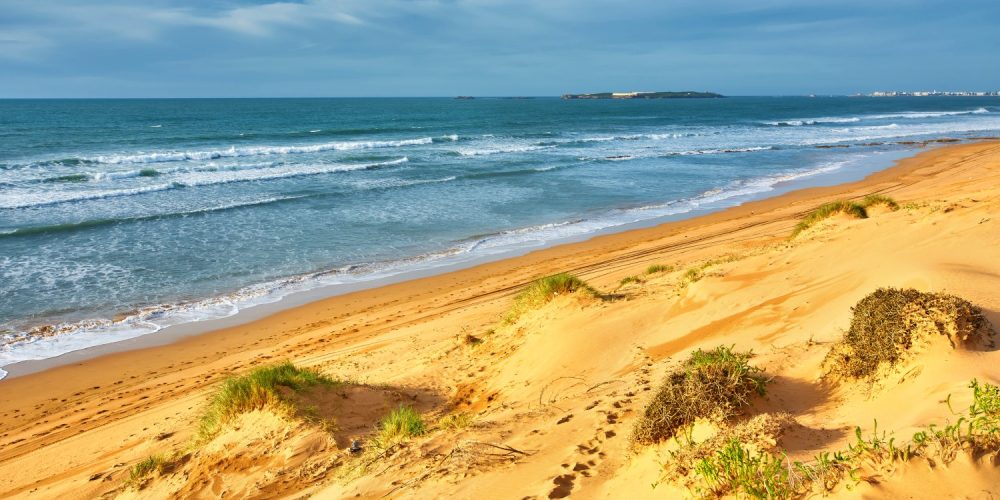
Morocco is a country with a rich and diverse natural heritage. From the sandy beaches of the Atlantic coast to the rocky mountains of the Atlas, from the green oases of the Sahara to the lush forests of the Rif, Morocco offers a variety of landscapes and ecosystems that will delight any nature lover. In this blog post, we will explore some of the best natural places in Morocco that you can visit and enjoy.
Beaches: Morocco has a long coastline that stretches for more than 3,000 kilometers along the Atlantic Ocean and the Mediterranean Sea. The beaches are diverse and offer different experiences depending on the region, the season and the activity. Some of the most popular beaches in Morocco are:

– Agadir: This is one of the most famous beach resorts in Morocco, located on the southwest coast. Agadir has a wide and sandy beach that is ideal for sunbathing, swimming and surfing. The city also has a lively nightlife, a modern marina and a golf course.

– Essaouira: This is a charming and historic town on the west coast, known for its fortified medina, its colorful souks and its artistic vibe. Essaouira has a long and windy beach that is perfect for kitesurfing, windsurfing and sailing. The town also hosts several cultural festivals throughout the year, such as the Gnaoua World Music Festival, which celebrates the music and culture of the Gnaoua people, who are descendants of former slaves from sub-Saharan Africa. The festival features concerts, workshops, exhibitions and ceremonies that showcase the diversity and richness of Gnaoua music and spirituality.
– Taghazout: This is a small fishing village on the south coast, near Agadir. Taghazout is a paradise for surfers, as it has some of the best waves in Morocco. The village has a laid-back atmosphere, with many surf shops, cafes and hostels. You can also enjoy yoga, hiking and camel riding in the nearby hills.
– Saidia: This is a modern and luxurious resort on the northeast coast, near the border with Algeria. Saidia has a long and golden beach that is ideal for relaxing, swimming and water sports. The resort also has a marina, a golf course and several hotels and restaurants.
Desert: Morocco is home to part of the Sahara Desert, the largest hot desert in the world. The desert covers about 20% of Morocco’s territory and offers an unforgettable experience for adventurous travelers. Some of the most amazing desert places in Morocco are:
– Erg Chebbi: This is one of the two major sand dune fields in Morocco, located in the southeast near Merzouga. Erg Chebbi has dunes that can reach up to 150 meters high and change color from golden to pink depending on the time of day. You can explore the dunes by camel, 4×4 or quad bike, or spend a night under the stars in a traditional Berber tent.
– Erg Chigaga: This is the other major sand dune field in Morocco, located in the south near M’hamid. Erg Chigaga is more remote and less touristy than Erg Chebbi, but equally impressive. You can enjoy the silence and solitude of the desert, or join a nomadic tribe for a glimpse of their lifestyle.
– Ait Benhaddou: This is a fortified village (ksar) on the edge of the desert, near Ouarzazate. Ait Benhaddou is one of **the most beautiful and well-preserved examples of Moroccan architecture**, dating back to
the 17th century. The village consists of several earthen buildings surrounded by high walls, decorated with geometric patterns and motifs. The village has been used as a filming location for many movies and TV shows, such as Gladiator, The Mummy and Game of Thrones.
– Moroccan architecture: This is a term that encompasses various styles and influences that have shaped the buildings and monuments of Morocco over centuries. Moroccan architecture reflects the diversity of its history, culture and geography, blending elements from Arab-Islamic, Berber, Andalusian, French and African traditions. Some of the main features of Moroccan architecture are:
– The use of arches, domes, courtyards and fountains as structural and decorative elements.
– The use of mosaic tiles (zellige), carved wood (mashrabiya), plaster (tadelakt) and metal (brass) as materials for ornamentation.
– The use of geometric patterns (arabesque), floral motifs (arabesque) and calligraphy (kufic) as artistic expressions.
– The use of colors such as blue (symbolizing water), green (symbolizing nature), yellow (symbolizing sun) and red (symbolizing earth) as aesthetic choices.
Moroccan architecture can be seen in various types of buildings such as mosques, palaces, riads, medinas, kasbahs and mausoleums. Some of the most famous examples of Moroccan architecture are:
– The Hassan II Mosque in Casablanca, the largest mosque in Africa and the third largest in the world, with a minaret that reaches 210 meters high.
– The Bahia Palace in Marrakech, a 19th century palace that showcases the opulence and elegance of Moroccan craftsmanship, with intricate mosaics, carved wood and stained glass.
– The Chefchaouen Medina in Chefchaouen, a 15th century town that is famous for its blue-painted houses and buildings, creating a stunning contrast with the green mountains around it.
– The Volubilis Ruins in Meknes, a UNESCO World Heritage Site that preserves the remains of a Roman city that was once the capital of the province of Mauretania Tingitana.
Leave a Reply